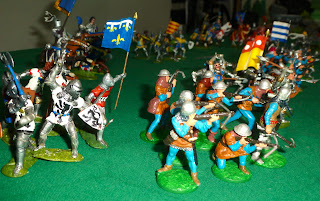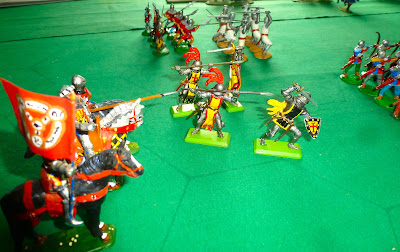Lionheart is a medieval boardgame published by Parker Brothers in 1997, played on a square grid with 25mm pieces the aim is to capture the enemy King or destroy all of his army, it plays a bit like a game of chess. We thought we'd try out the basic game to see if it would translate to a wargame with 54mm toy soldiers, here's how it went:
The English left wing shown above and the right wing pictured below, the basic game has 4 unit types: The King, mounted knights (2 units), infantry (5 units) and archers (2 units). For visual impact we doubled the number of figures in each unit, so the King got a standard bearer, each mounted unit was 4 figures and foot were 8.
There is an advanced version of the game that includes 3 more unit types: heavy foot knights, peasants and mercenaries but we left these out this time as we were just looking to test the game mechanics. One major change we did make was to play on a hex grid rather than a square one but this doesn't make any significant change to the dynamics of the game.
The French left wing shown above and the right wing pictured below. Players dice to see who goes first and then play on I go U go basis, as we'd doubled the number of figures in play we also doubled the number of actions allowed each move from 2 to 4. The actions allowed are: Move, Turn, Attack and the limit of 4 actions applies across the whole army not unit by unit, actions can be taken in any order i.e. 4 units could make 1 move or alternatively 1 unit could move, a second could turn while a third moved and attacked.
All units move in a straight line, mounted (King and knights) can move any number of hex for 1 action but foot units (infantry and archers) only move 1 hex for 1 action. No interpenetration through other units is allowed.
Archers can fire over friendly units and their range is anywhere in the arc of the 9 hex in front of them (2 hex, then 3, then 4). All other units attack when they move into direct contact with an enemy unit and have an action remaining to enable the attack i.e. for an infantry unit to move 2 hex and make an attack costs 3 actions.
The game uses 6 sided dice with symbols: 3 x Axe, 2 x Arrow and 1 x Panic. We used ordinary D6 with 1,2,3 = Axe, 4,5 = Arrow and 6 = Panic. A D6 is thrown for each foot figure in a unit and 2 x D6 for each mounted, so a maximum of 8 x D6 for each unit. Archers register a hit for every Arrow thrown, all other units make a hit when an Axe is rolled, casualties are removed: foot for 1 hit and mounted for 2 hits (rounded down). Combat is completed one unit at a time and hits are not cumulative.
If 4 x Panic dice are thrown the the unit attacked must turn and retreat one move i.e. a unit of 8 infantry attacks an enemy infantry unit, it throws 8 dice and scores: 3 x Axe, 1 x Arrow and 4 x Panic, the unit attacked suffers 3 casualties then must turn and retreat.
We found the rules very quick and easy to assimilate, the game flows fast and smoothly. Foot units advance rather ponderously and need to be supportive, a unit that becomes detached is liable to be picked off and overrun by enemy cavalry. On both sides archers made up 20% of the total units, so a decent representation but not enough to dominate the field and turn the game into just another shooting match. The mounted units are very much the arme blanche of the game, sudden sweeping charges packing a devastating punch, just as it should be.
We didn't include any terrain features but there is provision for this. Going forward I think we will take scenarios from One Hour Wargames, or perhaps based on historical events and introduce the additional 3 unit types (heavy foot, peasants and mercenaries). The simplicity of the rule system and lack of any record keeping also means that we could easily double the number of units and actions per turn to make it a much bigger game. It would be interesting to try an Agincourt scenario, with the flower of French chivalry facing a wall of English archers!
Apart from the Timpo crusaders, which have been based to give them more stability on the table.
all the rest of the figures are conversions, mostly from the talented hand of modeller and heraldic expert Vince Mattocks,

















































